IFS Officer’s Brilliant Way of Restoring a Himalayan Meadow Is Winning Acclaim
This first-of-its-kind conservation effort is completely eco-friendly — and being done at a height of nearly 11,000 feet above sea level. #IFS #Innovation
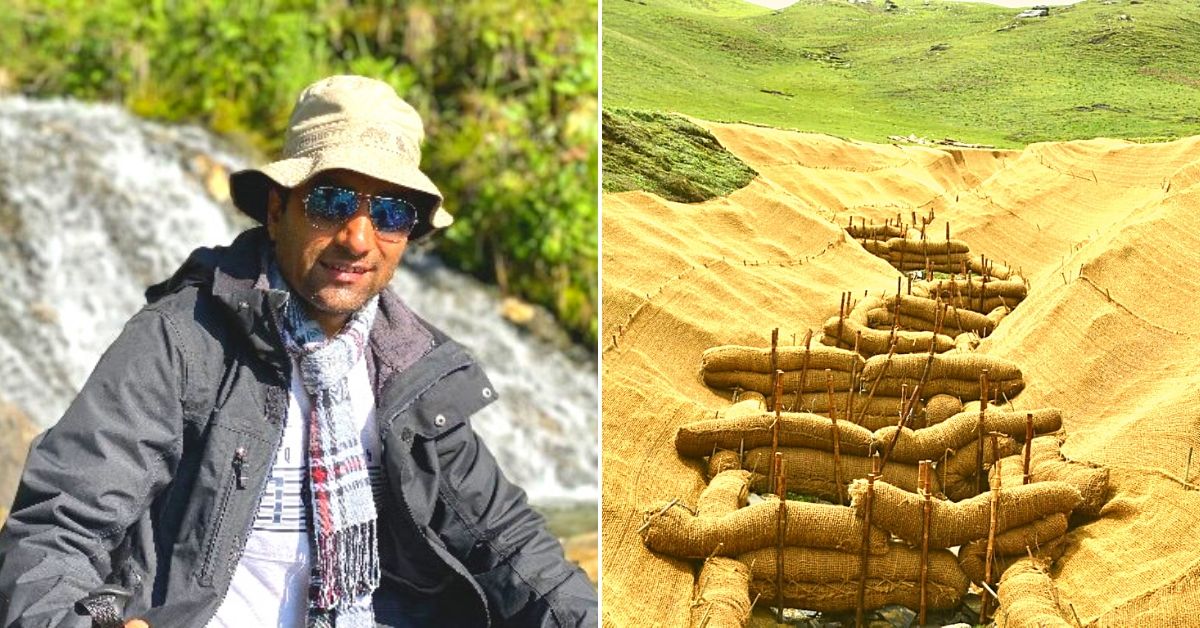
Since his posting three years ago, Sandeep Kumar, the Divisional Forest Officer (DFO) of Uttarkashi Forest Division and a 2011-batch IFS officer, has regularly visited the various bugyals—a bugyal is an ecologically sensitive high-altitude alpine meadow—in the region, including the landmark Dayara bugyal.
While its rolling patches are a popular tourist attraction, the rampant soil erosion has devastated the landscape and affected the plant ecology.
Having witnessed the degradation of these fragile ecosystems in the form of soil erosion and other associated problems, firsthand, Kumar arrived at a unique eco-friendly engineering method to restore them.
The first phase of this project began last year, and using geotextiles—permeable textiles utilised to increase soil stability, help drainage, establish erosion control and protect terrain—made of coir, along with with bamboo pegs and pine needles, locals repaired nearly 600 metres of the Dayara bugyal in Uttarkashi, which is perched at nearly 11,000 ft above sea level.
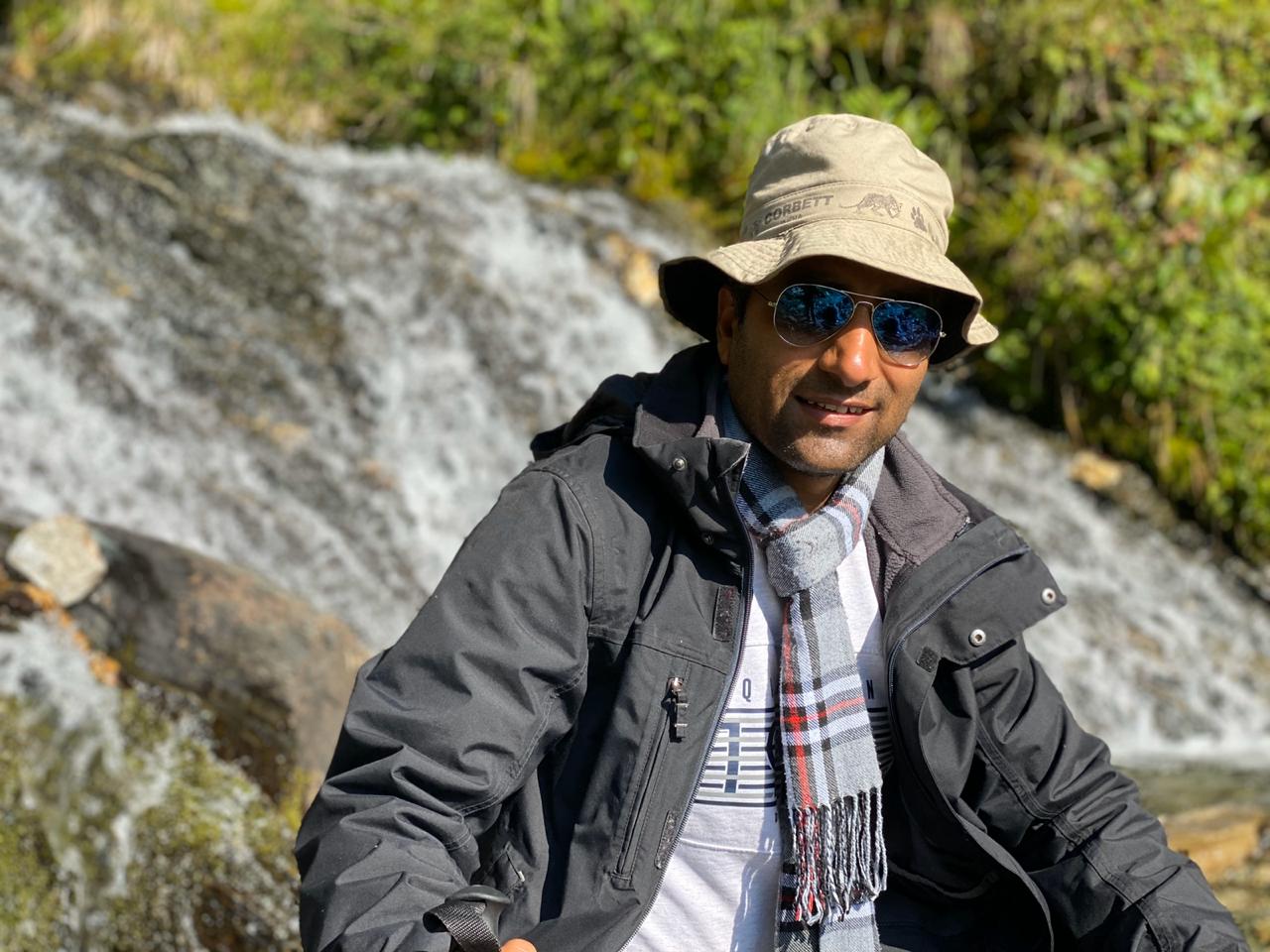
Why is it Important to Protect Bugyals?
Bugyals are essentially high altitude alpine meadows in the Himalayas rich with unique flora, particularly traditional medicinal and aromatic plants. They also adjoin forests, which makes an important part of the surrounding ecosystem.
“They are home to medicinal and aromatic plants like Kutki (Picrorhiza kurroa), Spikenard (Nardostachys jatamansi), Atis (Aconitum heterophyllum), Meetha (Aconitum Balfourii) and Dhup (Jurinca dolomiaea). These plants can only only grow in these specific climatic conditions, and you won’t find them anywhere else. Locals living in the vicinity share a very close bond with these meadows. They’ve conserved these parts for the use of traditional medicinal plants crucial for liver ailments and boosting immunity since time immemorial. Kutki, for example, is an ayurvedic herb. It’s not just the medicinal plants they’ve conserved but also the traditional knowledge behind their use. These plants are also used during village festivals that celebrate local gods and goddesses,” says Sandeep Kumar, speaking to The Better India.
In other words, these bugyals and the adjoining forests are crucial in terms of the biodiversity they hold and their cultural relevance. Thus, they require both preventive and remedial measures with the active participation of local villagers to re-establish the natural ecosystem.

Threat Perception & Addressing Them
A key threat to the existence of these bugyals is excess tourist influx, particularly in the summer months. However, since 2018, on the direction of the Uttarakhand High Court, the State forest department has prohibited night camping. Instead, they have demarcated night camping sites in the adjoining villages like Ghuyin and Barnala.
“The reason we banned night camping is because of excess garbage inflow and the possibility that they may trample the local flora. When you camp at a place, you need infrastructure to cook food, erect toilets and that creates more waste. The longer people stay, the greater the chances that they may damage local plant species. We wanted to restrict the daily presence of tourists in the bugyal as much as possible, and now, can only walk along the bugyal only in the day,” he notes.
Another major threat is over grazing. Since 2018, the forest department has zeroed in on the presence of the local Gujjar community and their buffaloes, who were often found camping in them. The big hoofed animals, particularly buffaloes, would end up trampling on important species of flora, and make the soil prone to erosion. So, the forest department has earmarked certain parts of the forests further away for them to graze.
The third threat was stray livestock of nearby local villagers. During these months (June, July, August), local villagers free up their cattle in the forest and let them loose, and the animals often find their way to the bugyals.
After prolonged discussions with nearby villages, the local State forest department helped form a committee called the Dayara bugyal Conservation Committee, and used the platform to have continuous deliberations with locals, who also have to confront the vagaries of climate change.
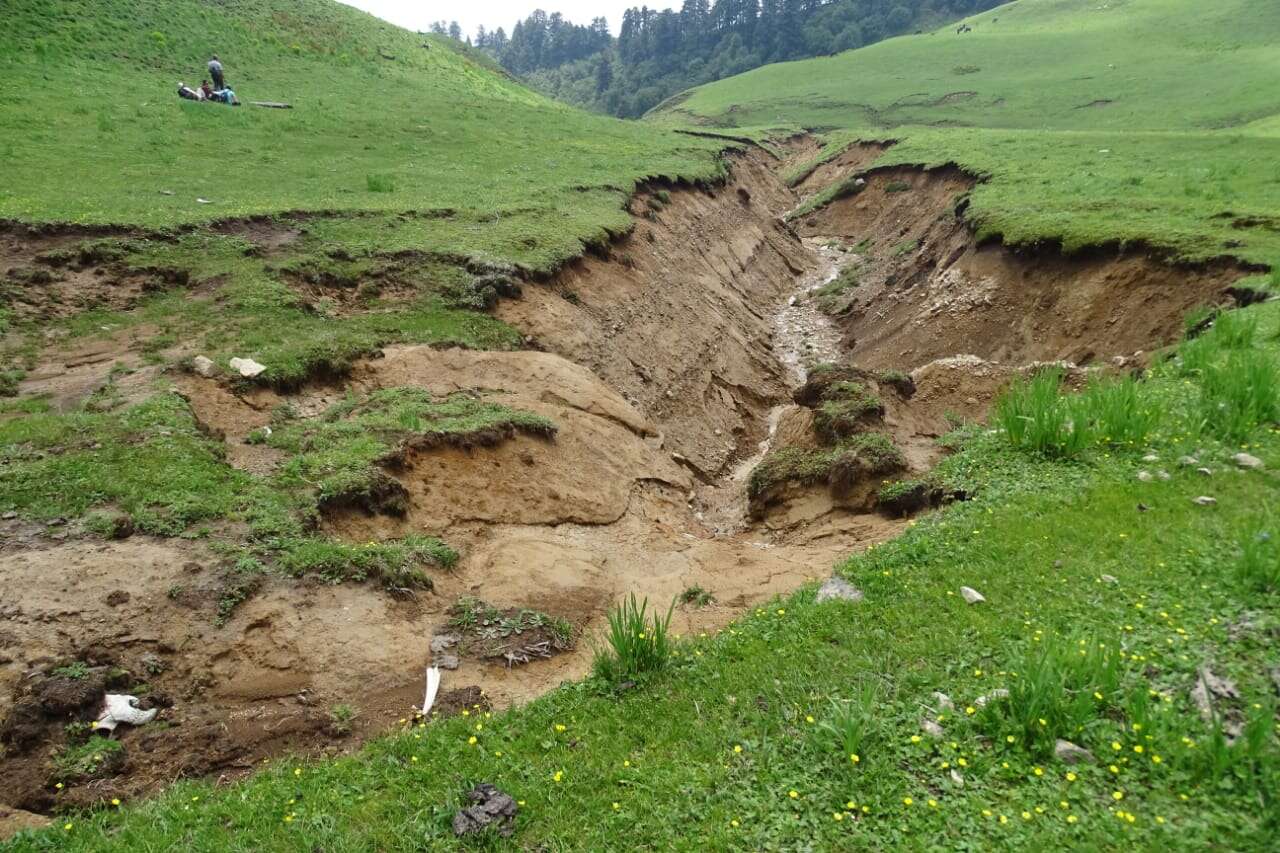
“We are in the process of completely eliminating the grazing pressure on the Dayara bugyal. As of now, it has come down to nearly nil across its 28 sq km area and that is a major improvement because at one point you would see 1500-2000 cattle grazing in the meadow at a time, and eating its fine grass. This was thanks to regular discussions and deliberations with the villagers of adjoining Raithal and Barsu. Also, remedial work in the meadow is being executed by local villagers which has not only provided employment opportunities to them but also inculcated a sense of ownership,” informs Sandeep.
Remedial Measures
Beyond preventive measures, what they needed was remedial measures to address soil erosion on these meadows thanks to anthropogenic pressures like uncontrolled grazing, and the consequent surface runoff and gully formation.
The surface of the Dayara bugyal is covered with natural green grass and seasonal flowers, and are thus very vulnerable to any external pressure on it since they slope downwards.
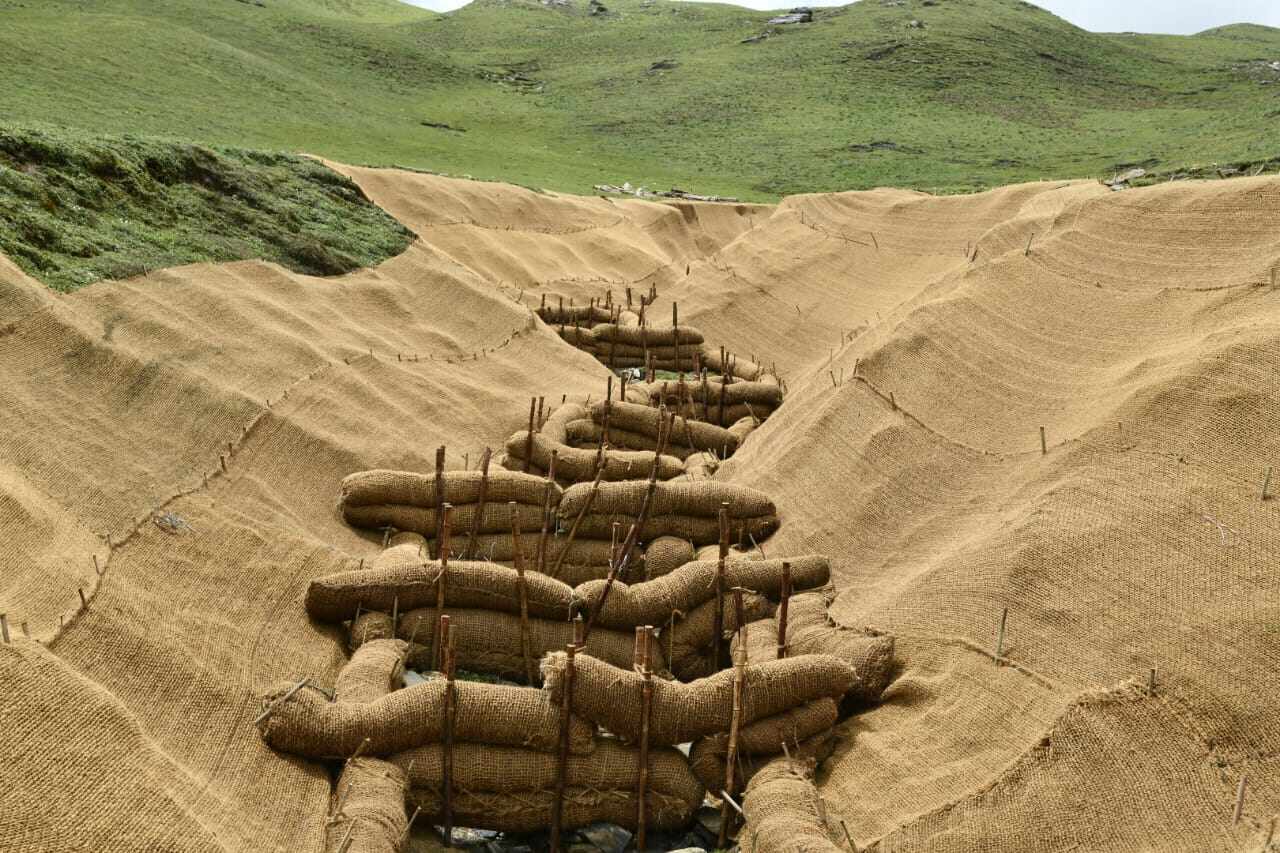
What begins as sheet erosion, the “uniform removal of soil in thin layers by the forces of raindrops and overland flow” (source: The National Soil Erosion Research Laboratory) soon turns into rill erosion, “removal of soil by concentrated water running through little streamlets” (source: The National Soil Erosion Research Laboratory), and eventually gully erosion, a commonplace form for erosion accentuated by the flow of surface water. This results in the formation of channels through the meadows.
There was continuous cutting of the soil all through the middle of the bugyal, which in turn, severely damaged the site and plant species thriving on it.
“We assessed the area and accordingly prepared a plan for it sometime in June-July 2019. In light of its fragile nature, our working plan prohibited any concrete structures in the area, and we were left with very few options to treat these alpine meadows. So, we looked for an eco-friendly approach that would heal the already exposed surface, arrest soil erosion for a couple of years and help rejuvenate the area on the basis of assisted eco-restoration. We wanted to ensure that our intervention wouldn’t have any adverse environmental impact on such a sensitive ecosystem,” he says.
The plan, therefore, had four key components to it:
1) Make a plan to arrest soil erosion and gully formation through matting of eco-friendly coir geo-textile.
2) Making channels and check dams of coir logs made up of coir geo-textile stuffed with pine needles.
3) Fix the coir geo-textile, channels and check dams with bamboo pegs and stumps instead of iron rods and pegs.
4) Planting of local species like Iris kumaonensis and Rosa Sericea to rejuvenate the area to its original beauty.
Geo-matting the areas degraded by massive soil erosion coupled with the embankment of channels made up of coir-pirul (pine needles) logs not only prevents soil erosion but also controls lateral bank cutting all along the gully, and provides stability to the soil. The bamboo supported coir-pirul check-dams fitted across at defined intervals all along the channel decrease the speed of water flowing through it and also filter the soil content, thereby reduces debris load in the downstream areas.
The technique is based on a top-down approach, which means treatment started from an initial point upstream with less volume of water and debris, and progressed to lower areas where the problem becomes severe with more water and high speed. These structures gradually reduce the debris load and speed as water approaches the lower areas, thus protecting the downstream from further degradation.
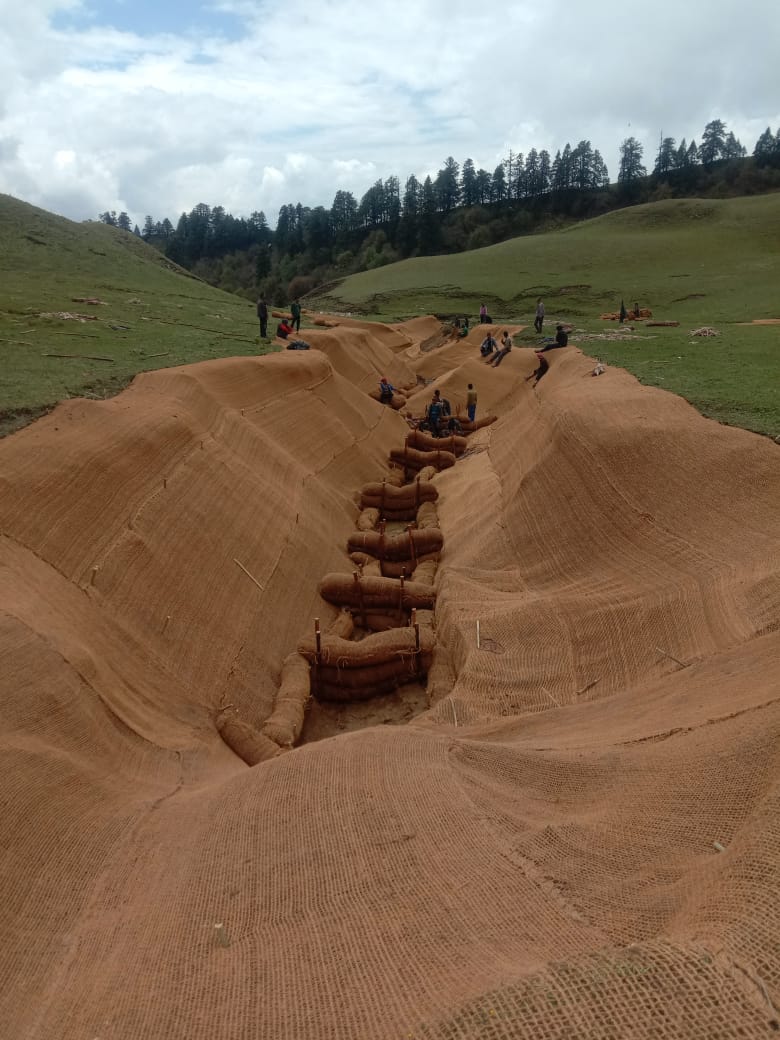
To cover the already eroded area and heal the widening of the gullies, Sandeep informs that mats made of coir geo-textiles were used to make walls along the damaged part of the meadows, that were completely filled with pine needles and dry leaves. Around 9,000 square metres of coir geo-textile was supplied for this particular project.
Going further, check dams were erected on the gullies where the water flowed through the mats stacked one above the other to reduce the speed of the water and filter soil from the water. The objective was to reduce the speed of water and arrest the erosion of soil. Bamboo stumps were used to support the check dams. Meanwhile, bamboo pegs were used to fix up the mats instead of iron pegs.
“We covered the lateral sides of the gully with coir geo-textile mats. In order to reduce the speed of the water within the gully, we installed special check dams 4-5 metres apart. These check dams were installed to arrest the soil that is already in the water and decrease the speed of the water, geotextile mats were installed on both edges of the channel so that the flowing water is not in direct contact with the soil,” he says.
“Coir geo-textile mats can be used for preventing soil erosion and road construction. In such projects, first, the geo-textile is laid, then plantation work is carried out, which helps in holding the soil along with the textile. Coir textile prevents soil erosion and dissolves over time in the meadows, acting as manure for vegetation. When plants germinate, the geo-textile turns into mulch in almost a year’s time, and in another year, the geo-textile completely dissolves in the soil and acts as a manure for the same vegetation and also helps in further growth to prevent soil erosion,” says Sushil Bhatt, the Dehradun-based assistant manager of Coir Board of India, speaking to the Hindustan Times earlier this month.
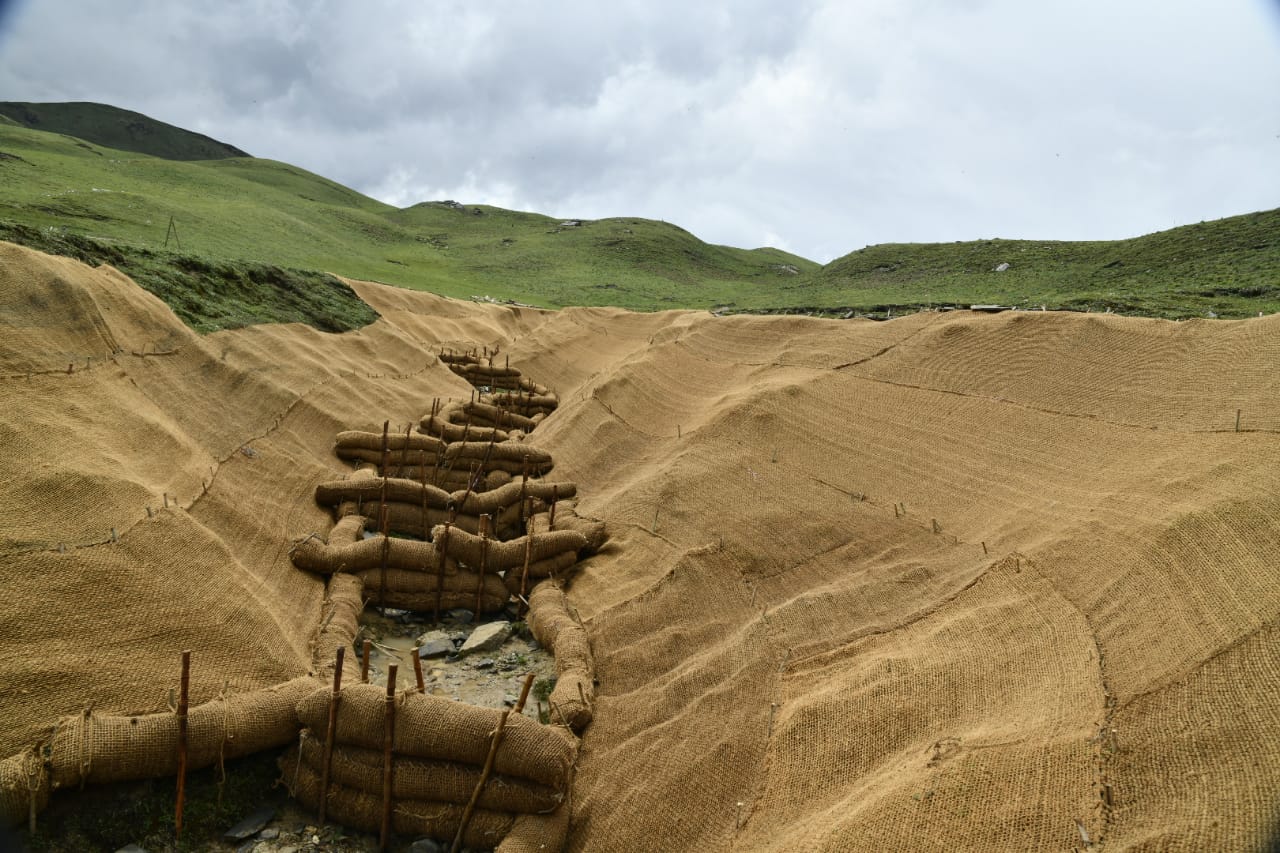
Local Engagement
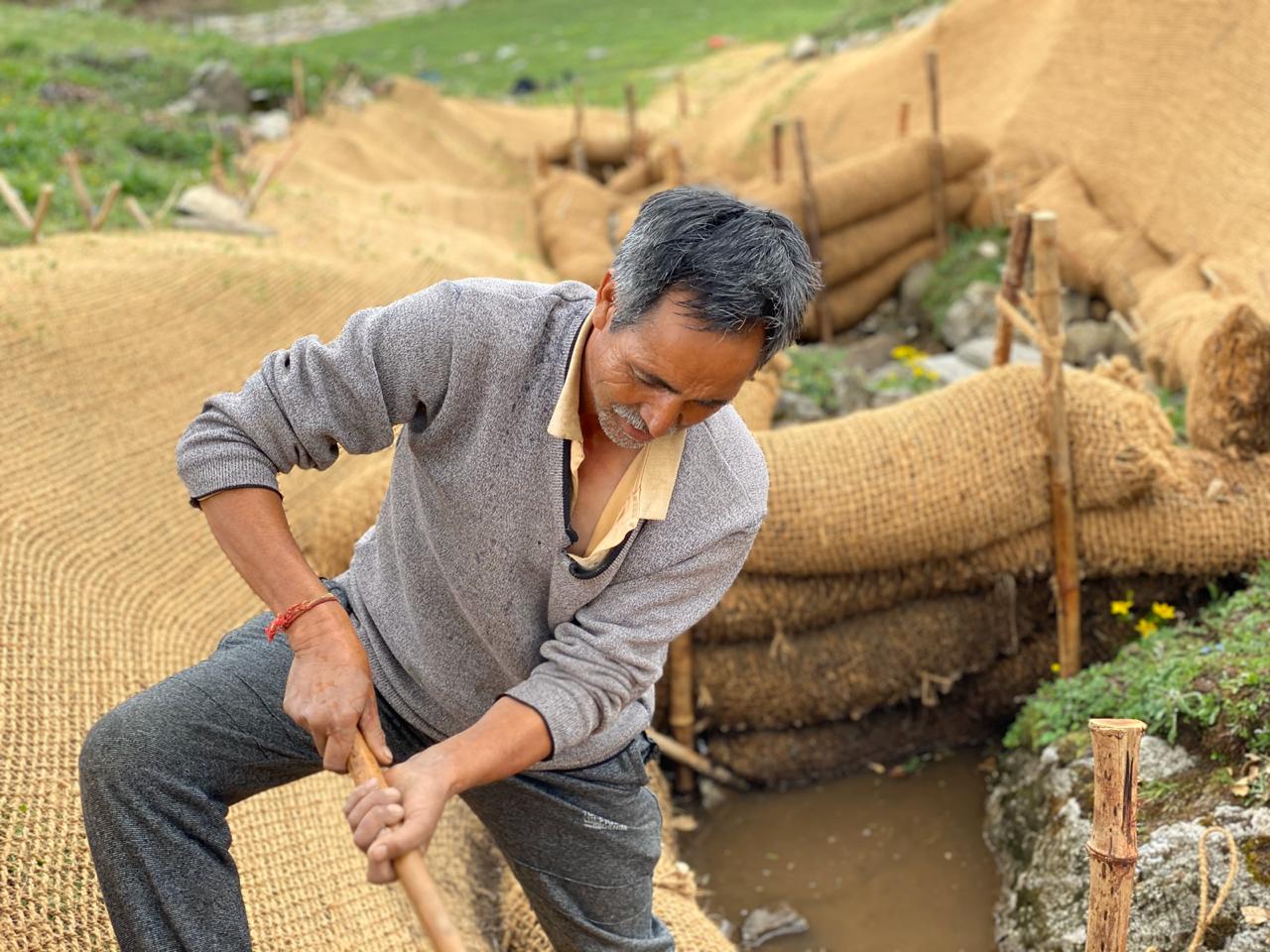
A fundamental facet of this endeavour was employing local villagers to implement this project.
“The project generated a lot of employment, and also gave the locals a sense of ownership. Although the forest department bought the bamboo from the Bamboo Board of Uttarakhand, the stumps and pegs were prepared by a local SHG. We hired locals for our transport and labour needs. We also used local ponies to transport the mats. Even the collection of pine needles, and stuffing the coir with them was done by locals,” says Sandeep.
All the material was prepared by October 2019 and the actual laying work happened in November 2019. By November end, there was complete snowfall. Actual implementation doesn’t take much time, and there were 40-50 labourers working on it.
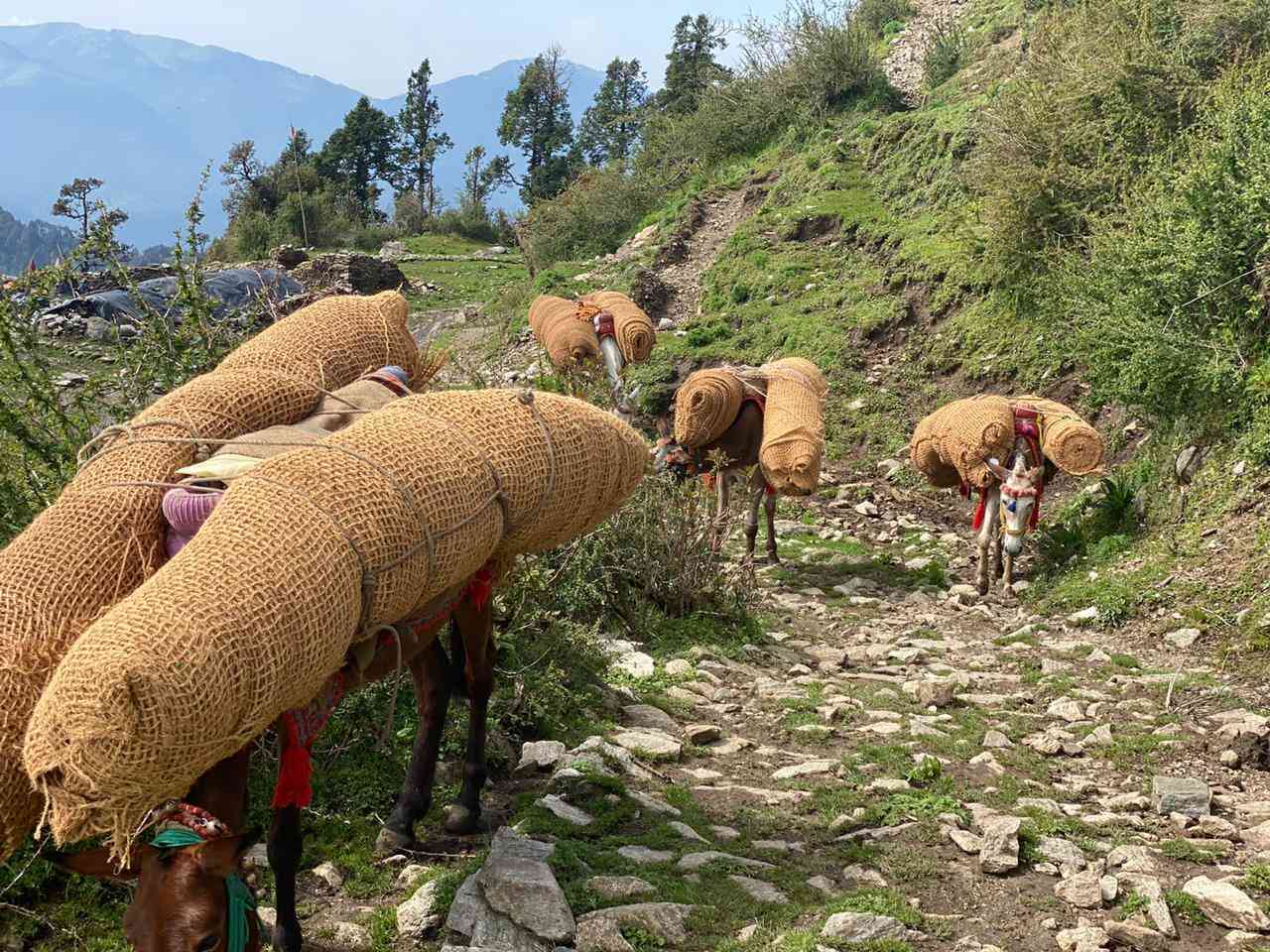
“This is a first-of-its-kind project and we are already seeing rejuvenation of the area in terms of green shoots coming out of the coir mat. But it’s too early to say it has succeeded completely. In the next five-six months, the picture will be clearer. This technique may be replicated in other bugyal (alpine meadow) restoration projects in future. This is the most pristine ecosystem of the Himlayas, and I am confident our efforts will bear fruit,” he says.
(Edited by Gayatri Mishra)
Like this story? Or have something to share? Write to us: [email protected], or connect with us on Facebook and Twitter.
If you found our stories insightful, informative, or even just enjoyable, we invite you to consider making a voluntary payment to support the work we do at The Better India. Your contribution helps us continue producing quality content that educates, inspires, and drives positive change.
Choose one of the payment options below for your contribution-
By paying for the stories you value, you directly contribute to sustaining our efforts focused on making a difference in the world. Together, let’s ensure that impactful stories continue to be told and shared, enriching lives and communities alike.
Thank you for your support. Here are some frequently asked questions you might find helpful to know why you are contributing?


This story made me
-
97
-
121
-
89
-
167











